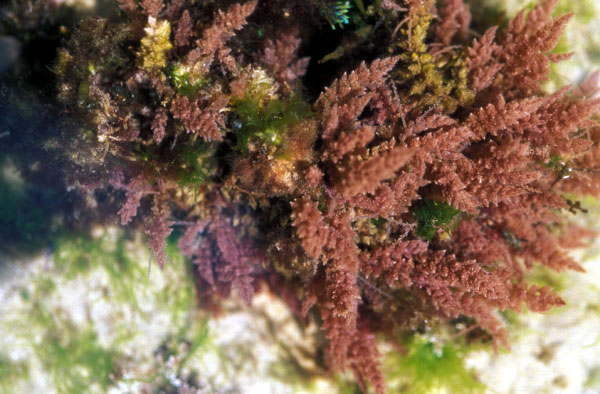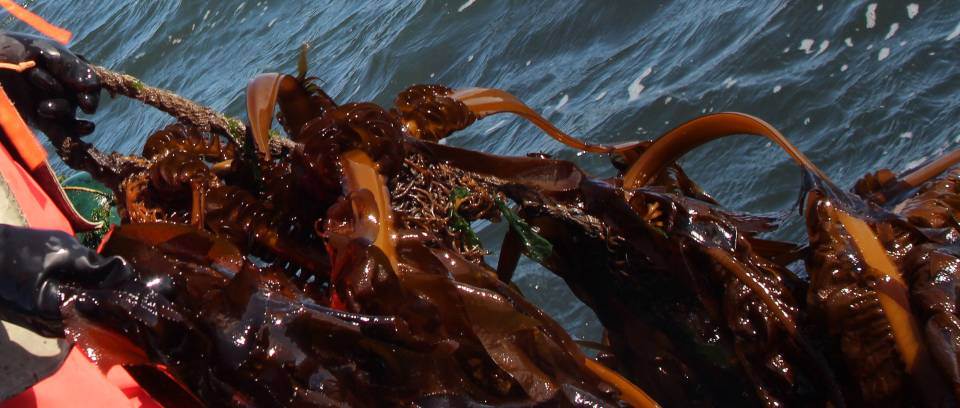The seaweed Gracilaria edulis is a fast growing agarophyte and its distribution is confined to Tamil Nadu, Andaman-Nicobar islands, Lakshadweep group of islands and Chilka lake along the Indian Coast. In Lakshadweep, it has been reported growing abundantly in the islands of Agatti, Kavaratti, Kalpeni and Kadamath while in Minicoy it was totally absent till recently. In 1990 this seaweed was transported from Mandapam (Gulf of Mannar) and Kavaratti islands (Lakshadweep) to study the feasibility of its establishment and colonizing in the lagoon in Minicoy.
Digital library
-
-
- Four species of seaweeds biochemically characterized for biorefinery
- Mild fractionation required to preserve chemical structure
- Seaweed carbohydrates can be hydrolyzed and fermented to ABE
- Monetizing of all fractions is needed for viable biorefinery
-
Thirty species of marine algae collected from different localities of Mandapam coast (Gulf of Mannar) were analyse!! for their photosynthetic pigments suct. as chlorophyll and carotenoids. The lowest value. of chlorophyll as well as carotenoids content were found in Rhodophyceae. The grouping and separation of algae based on coloration has been practiced for over 100 years (Harvey, 1841). Pigments such as chlorophyll and carotenoids play important roles in photosynthesis. Several studies have been conducted in the algal pigment by Ramus el al. (1976); Brody el al. (1959); Jones el at. (1965) and Waaland el al. (1974). As there is no detailed work in this line on India.l seaweeds, the present study.of thirty species of marine algae belonging to Chlorophyta, Phaeophyta and Rhodophyta from Mandapam coast has been carried out.
-
In this study the efficacy of using marine macroalgae as a source for polyunsaturated fatty acids, which are associated with the prevention of inflammation, cardiovascular diseases and mental disorders, was investigated. The fatty acid (FA) composition in lipids from seven sea weed species from the North Sea (Ulva lactuca, Chondrus crispus, Laminaria hyperborea, Fucus serratus, Undaria pinnatifida, Palmaria palmata, Ascophyllum nodosum) and two from tropical seas (Caulerpa taxifolia, Sargassum natans) was determined using GCMS. Four independent replicates were taken from each seaweed species. Omega-3 (n-3) and omega-6 (n-6) polyunsaturated fatty acids (PUFAs), were in the concentration range of 2-14 mg/g dry matter (DM), while total lipid content ranged from 7-45 mg/g DM. The n-9 FAs of the selected seaweeds accounted for 3%-56% of total FAs, n-6 FAs for 3%-32% and n-3 FAs for 8%-63%. Red and brown seaweeds contain arachidonic (C20:4, n-6) and/or eicosapentaenoic acids (EPA, C20:5, n-3), the latter being an important "fish" FA, as major PUFAs while in green seaweeds these values are low and mainly C16 FAs were found. A unique observation is the presence of another typical "fish" fatty acid, docosahexaenoic acid (DHA, C22:6, n-3) at ≈ 1 mg/g DM in S. natans. The n-6: n-3 ratio is in the range of 0.05-2.75 and in most cases below 1.0. Environmental effects on lipid-bound FA composition in seaweed species are discussed. Marine macroalgae form a good, durable and virtually inexhaustible source for polyunsaturated fatty acids with an (n-6) FA: (n-3) FA ratio of about 1.0. This ratio is recommended by the World Health Organization to be less than 10 in order to prevent inflammatory, cardiovascular and nervous system disorders. Some marine macroalgal species, like P. palmata, contain high proportions of the "fish fatty acid" eicosapentaenoic acid (EPA, C20:5, n-3), while in S. natans also docosahexaenoic acid (DHA, C22:6, n-3) was detected.
-
FAO fisheries fact sheet of Porphyra tenera (Kellman 1897), also known as nori and laver.
-
A round-table discussion to plan for the future.
-
Data collected on the commercial exploitation of seaweeds from the natural seaweed beds of Tamilnadu during 4 years period from 2000 to 2003 showed that the quantity of agarophytes viz. Gelidiella acerosa, Gracilaria edulis, G.crassa, G.foliifera and G.verrucosa varied from 965 to 15 18 tonnes (dry wt) and alginophytes Sargassum spp and Turbinaria spp from 1433 to 2285 tonnes (dry wt) per year. The commercial harvest of seaweeds in Gulf of Mannar and Palk Bay is recommended only during the peak growth period of the algae from July 1 August to January. The harvest of commercially important seaweeds in a rational way from other parts of Indian coast, Lakshadweep and Andaman-Nicobar Islands is suggested. The need for large scale cultivation of agarophytes to augment the resources and uninterrupted supply of raw materials to the seaweed industries is emphasised.
-
The survey of marine algal resources conducted by CMFRI along Tamil Nadu coast during 1971-76. The standing crop from the total area of 17,125 ha was estimated at 22,044 tonnes (wet wt.), consisting of 1,709 tonnes of agarophytes, 10,266 tonnes of alginophytes and 10,069 tonnes of other seaweeds. The resources of the commercially important species are 74 tonnes of Gelidiella acerosa, 914 tonnes of Gracilaria spp., 798 tonnes of Hypnea spp., 9,381 tonnes of Sargassum spp. and 714 tonnes of Turbinaria spp. The year to year fluctuation in the quantity of alginophytes landed was due to the variation in the demand of the major algin producing industries based on their supply orders for sodium alginate.
-
The study analyzed the characteristics, chemical composition, and in vitro gas production kinetics of Porphyra umbilicalis and Saccharina latissima silages. Each seaweed was ensiled in vacuum bags (three bags/silage) following a 2 × 3 factorial design, with two pre-treatments (unwilted or pre-wilted) and three silage types: unwashed seaweed ensiled without additive; seaweed washed and ensiled without additive; and seaweed washed and ensiled with 4 g of formic acid (FAC) per kg seaweed. Silages were kept for 3 months in darkness at 20 °C. Pre-wilting prevented (p < 0.001) effluent formation and reduced (p ≤ 0.038) the production of NH3-N and volatile fatty acids for both seaweeds. Both pre-wilting and washing increased (p < 0.05) the ruminal degradability of P. umbilicalis silages but not of S. latissima silages. The pH of the FAC-treated silages was below 4.0, but ranged from 4.54 to 6.23 in non FAC-treated silages. DL-lactate concentrations were low (≤23.0 g/kg dry matter) and acetate was the predominant fermentation product, indicating a non-lactic fermentation. The estimated ruminal degradability of the P. umbilicalis and S. latissima silages was as average, 59.9 and 86.1% of that for high-quality rye-grass silages, respectively, indicating a medium-low nutritional value of these seaweed silages for ruminants.
-
Seaweeds constitute one of the commercially important marine living renewable resources. They are the only source for the production of phytochemicals such as agar, agarose, carrageenan and algin which are widely used in various industries as gelling, stabilising and thickening agents. Seaweeds are good sources of food and medicine. Food products like jelly, jam, pickle etc. can be prepared from seaweeds. Many bioactive compounds can be extracted from seaweeds. Seaweed meal and seaweed liquid fertilizer are also' manufacture.d from marine algae. The methods for manufacturing different phyto-chemicals and products from seaweeds are given in this paper.





